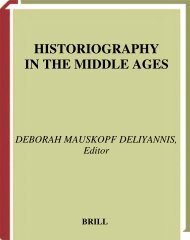Medieval Sexuality: A Casebook - Julian Emperor
Medieval Sexuality: A Casebook - Julian Emperor
Medieval Sexuality: A Casebook - Julian Emperor
You also want an ePaper? Increase the reach of your titles
YUMPU automatically turns print PDFs into web optimized ePapers that Google loves.
40 Dominic Janesbenevolence in a “dark age” and that was why God allowed it to exist at all. 43The Dark Ages—published in 1844 by the archbishop of Canterbury’s librarianSamuel Maitland—represented the first substantially positive Anglican study ofmedieval monasticism, but even he was keen to distance himself from any thoughtthat he was in favor of a monastic revival. 44 For at stake, among other things,was the dangerous progress of the Anglo-Catholic movement within the Churchof England that sought to restore elements of religion, including monasticism,confession and penance, that had been abolished or marginalized at the Reformation.The storm over ritualism (the revival or reinvention of abandoned ceremonial)lasted through the second half of the nineteenth century and led to the passingof the Public Worship Regulation Act (1874), under which there were a numberof prosecutions, the most prominent of which was of the bishop of Lincoln,Edward King, in 1890. 45 He was acquitted on several counts but was instructedto desist from making the sign of the cross during the Eucharist. 46 This puts intocontext earlier Anglican readings of such penitential prescriptions as the IrishmanColumbanus’s requirement that a monk failing to make the sign of the cross overhis spoon at dinner should be given six lashes. 47 Nevertheless, the prosecution ofthe bishop of Lincoln was in many ways half-hearted and the Anglo-Catholicswere tacitly allowed their place. The compromise position on confession, expressedin Prescott’s 1896 tract, was that absolution can only be granted by God,but might, exceptionally, as “a tonic, not daily food,” be given via a priest. 48Modern equivalents of the medieval penitentials were regularly read andcited by opponents of “auricular” confession—in other words, that given privatelyto a priest and accompanied by penance where appropriate. The vital text in usefor Roman Catholic confession was the Garden of the Soul by the English bishopRichard Challoner (1691–1781). It was the most important Catholic Prayer Bookin England of the period. Its importance can be seen from the fact that it had farmore editions than the official Roman Raccolta, which appeared in Latin in 1807,but not in English until 1857. 49 The method of confession was for the penitent tokneel down at the side of the priest, to make the sign of the cross and ask hisblessing, then to list any sins. The priest then gave absolution and penance. 50 Thesort of questions that gave Protestants thrills and nightmares were those such as:[Have you been] guilty of self-pollution? Or of immodest touches of yourself?How often?; have you looked at immodest objects with pleasure?; kept indecentpictures?; have you abused the marriage bed by any actions contrary to the orderof nature? Or by any pollutions? Or been guilty of any irregularity, in order tohinder your having children?and (ironically?):have you taught anyone evil which he knew not before? 51













